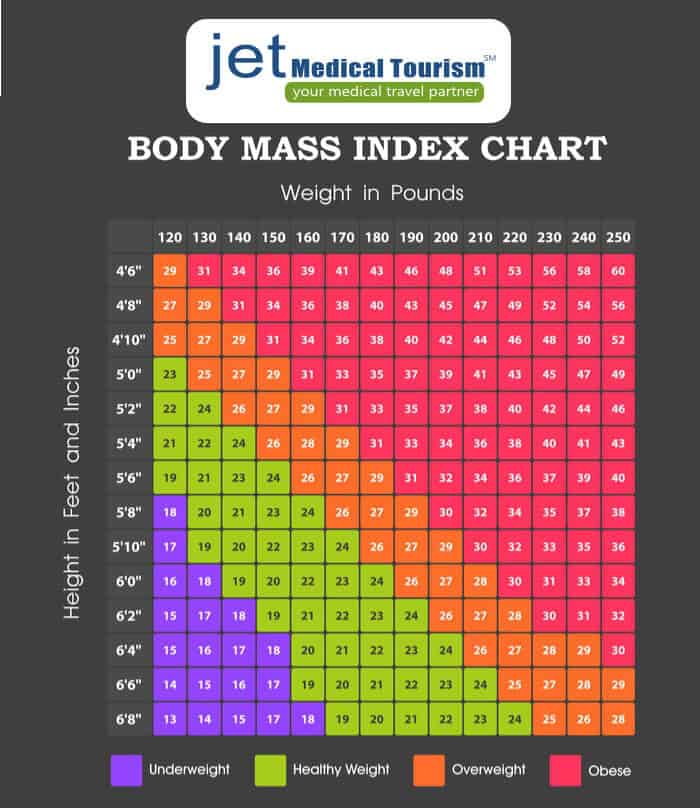BMI – Body Mass Index
 BMI stands for Body Mass Index. Its a calculation that takes into account your weight and height. The Body Mass Index is used as a screening tool or an indicator that measures body fatness.
BMI stands for Body Mass Index. Its a calculation that takes into account your weight and height. The Body Mass Index is used as a screening tool or an indicator that measures body fatness.
BMI is known to be one of the most inexpensive methods of calculating the weight category of a person.
Its important to know your BMI and what category you fall in such as underweight, normal weight, overweight or obese.
A high BMI often indicates high body fat which increases the risk for certain chronic health problems.
BMI categories
According to the U.S. Department of Health & Human Services, and that with a BMI below 18.5 is underweight. People with a BMI between 18.5 and 24.9 are considered to have a healthy or normal weight. Overweight adults have a BMI between 25 and 29.9. An adult with a BMI of 30 and above is considered obese.
- Underweight = <18.5
- Normal weight = 18.5–24.9
- Overweight = 25–29.9
- Obesity = BMI of 30 or greater
How do you calculate BMI
For both adults and children, BMI is calculated the same way. The calculation is based on either the Imperial System of Measurement or the Metric System of Measurement. In the United States, we use the older Imperial System of Measurement where things are measured in feet, inches and pounds.
The two formulas are:
Imperial System of Measurement (pounds and inches):
Using the imperial system, BMI for gastric sleeve is calculated by dividing your weight in pounds (lbs) by your height in inches (in) squared and multiplying by a conversion factor of 703.
- Formula: weight (lb) / [height (in)]2 x 703
- Example: Weight = 200 lbs, Height = 5’5″ (65″)
- Calculation: [200 ÷ (65)2] x 703 = 33.27 BMI
Metric System of Measurement (kilograms and meters):
Using the metric system, BMI is calculated by dividing your weight in kilograms (kg) by your height in meters (m) squared. Because height is measured in centimeters, divide height in centimeters by 100 to get height in meters.
- Formula: weight (kg) / [height (m)]2
- Example: Weight = 68 kg, Height = 165 cm (1.65 m)
- Calculation: 68 ÷ (1.65)2 = 24.98 BMI
Body mass index chart
There are several online tools that can be used to calculate BMI easily and quickly. One of the more popular tools is called the BMI Chart or Body Mass Index Chart. People who are more visually oriented find the BMI Chart easy to read and understand.
It helps to categorize people on the basis of their weight as underweight, healthy weight, overweight and obese. For example, find your height along the left side of chart then locate your weight at the top. Next, slide your finger down until reach the BMI number at the intersection.

Why does BMI matter
BMI has immense clinical relevance and is a useful measure of overweight and obesity. In general, having a high BMI increases the risk of developing a range of conditions linked with excess weight, including:
- Chronic heart diseases
- Type 2 diabetes
- High blood pressure (hypertension)
- High cholesterol levels
- Gall bladder diseases
- Stroke
- Osteoporosis
- Arthritis
- Sleep apnea
- Several types of cancer (breast, colon and prostate)
Conversely, having a BMI in the low range could indicate that your at risk of being malnourished. This means that your body may be deprived of vitamins, minerals and other important nutrients.
In addition to BMI, several other factors are also used to calculate imminent health risks associated with obesity and high body fat. Factors such as blood sugar level, family history of diseases, smoking, age, gender, level of activity and so forth.
High BMI is linked to diabetes
Researchers have linked obesity to heart diseases, cancer and type 2 diabetes. Obesity is no longer related to the age factor. Today there are a large number of younger people and children who are diagnosed as overweight and obese.
Even though the exact reason or cause of diabetes is still a mystery, obesity is one factor that increases the risk of developing type 2 diabetes. Studies prove that people who are obese are 80% more likely to develop type 2 diabetes.
There is also a greater risk of developing the disease if the person has accumulated excess fat around the abdomen. It is also known as abdominal obesity.
Insulin resistance
Due to high abdominal fat, the cells release a particular type of chemical which are pro-inflammatory. These chemicals disrupt the function of cells that are responsive to insulin, making the body insulin resistant, which is the main symptom of diabetes mellitus.
Changes body metabolism
Excessive body fat is also known to change the overall metabolism of the body. Obesity causes the adipose or fat tissues in the body to release fat molecules into the blood stream. This reduces insulin sensitivity of the body.
Scientists also believe that obesity can cause pre-diabetes, a condition that develops into diabetes in the later stage.
Without regular exercise and a healthy diet, obesity can cause several ailments apart from diabetes within a short period of time. However, the great news is that by lowering BMI and reducing body weight, you can also reduce the risk of developing type 2 diabetes and other related health issues.
It is also possible to delay the onset of diabetes by exercising and losing weight gradually.
High BMI is linked to heart diseases
Known to be one of the leading causes of death, heart diseases are directly linked to obesity. One of the most common types of heart disease occurs when the blood vessels that carry blood to the heart become narrow and clogged.
This prevents the heart from receiving the blood it requires for pumping. It can cause heart attacks, heart failure, abnormal heart rhythm and so forth. There are several types of heart diseases that occur mainly due to obesity.
Heart diseases are often linked to various other ailments such as high blood pressure or hypertension, high blood sugar and high cholesterol levels. All these ailments can eventually lead to heart diseases.
Weight loss and regular exercise can help reduce the risk of heart diseases as it tends to reduce high blood pressure and blood sugar levels. A healthy and balanced diet is another way to reduce weight and lower the risk of developing heart diseases.
High BMI is linked to strokes
Excessive fat in the body or the condition known as obesity causes hypertension. Stroke is mainly caused due to high blood pressure. Strokes can be prevented by reducing body weight which in turn reduces blood pressure level. Therefore it is quite pertinent to keep blood pressure level under control.
There are many ways to prevent obesity and control your weight. Healthy eating and regular exercise are the two simple ways to prevent obesity and other related health issues. Have a balanced and healthy diet of fruits, vegetables, whole grains and lean sources of protein such as poultry, fish, nuts and soy.
Another method to promote weight loss is with different types of bariatric surgery which is considered to be quite effective as it reduces numerous health risks associated with obesity.
Find out if you qualify for the Tijuana Mexico Gastric Sleeve by clicking through to our online application form or contact us today to find out more.
[button link=”https://jetmedicaltourism.com/apply/” type=”big” color=”blue” newwindow=”yes”] See If You Pre-Qualify[/button]
[button link=”https://jetmedicaltourism.com/contact/” type=”big” color=”blue” newwindow=”yes”] Contact Us Today[/button]



